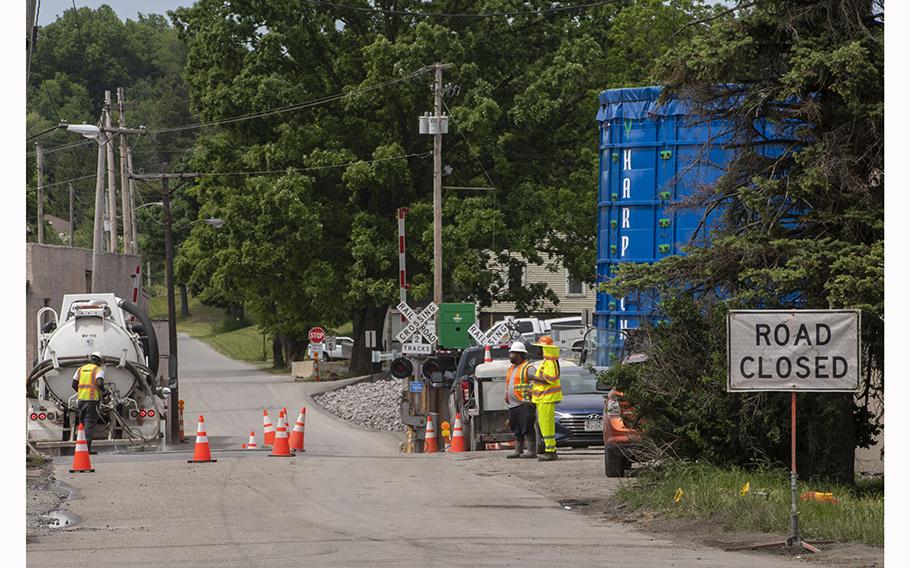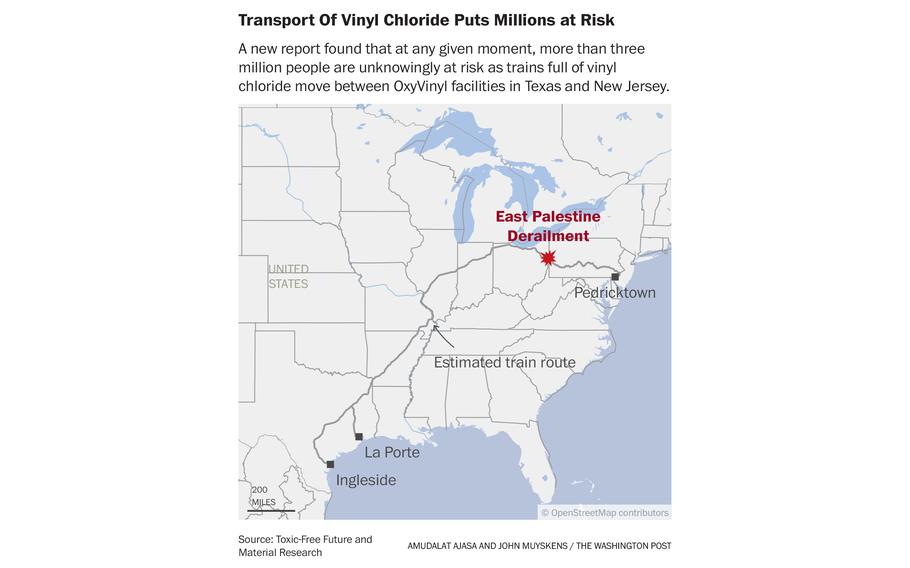
Environmental monitoring continues near railroad tracks in East Palestine, Ohio, on May 28, 2023. Less than a year ago, a disastrous train derailment sent a massive plume of dangerous chemicals billowing over East Palestine. Now, a new report warns that more of these catastrophes may loom. (Nate Smallwood/Bloomberg)
Less than a year ago, a disastrous train derailment sent a massive plume of dangerous chemicals billowing over East Palestine, Ohio, startling the town of nearly 5,000 residents and onlookers nationwide. Now, a new report warns that more of these catastrophes may loom: At any given moment, more than an estimated 3 million people are unknowingly at risk, as toxic trains full of a highly combustible and carcinogenic chemical used to make plastic move between Texas and New Jersey.
The report, published by Toxic-Free Future, an environmental health research and advocacy group, and Material Research, a group researching toxic pollution and inequity, created a map estimating a regular route for nearly 36 million pounds of the chemical, vinyl chloride. The path begins with OxyVinyl plants in Texas — a leading producer of the substance — to factories in New Jersey. The toxic chemical is normally used in polyvinyl chloride products — plastic materials including pipes, cable coatings and packaging materials.
Throughout any day, more than 200 rail cars filled with the chemical are moved across nearly 2,000 miles of U.S. railways — including through major population centers, the report said. And some experts worry that without intervention, the mass transport of the substance is another environmental health disaster just waiting to happen.
The threat that “bomb trains” pose as they move throughout communities, and the disasters that they have already created, should be enough to reconsider the chemical’s distribution entirely, report co-author Mike Schade said.
“These accidents aren’t happening every day. They’re not happening every month. But it’s going to happen again,” said Schade, from Toxic-Free Future. “And we think that the best way to prevent the next big disaster involving vinyl chloride is to phase out its production and use.”
Asked for comment, OxyVinyl told The Washington Post the company does not discuss the transportation of its products.
In December, the Environmental Protection Agency launched a formal evaluation of the risks of vinyl chloride, a process that could take at least three years. The EPA said it would study whether the chemical poses an “unreasonable risk to human health or the environment.”
Republican senators on Wednesday grilled the head of the EPA’s chemicals office, Michal Freedhoff, about the decision during a heated hearing.
Sen. Markwayne Mullin, R-Okla., accused the Biden administration of engaging in “almost a war on plastic,” noting that vinyl chloride is found in polyvinyl chloride plastic, better known as PVC. “It raises alarms because we use PVC piping in almost all your homes now, either through your drainage or your water,” Mullin said.
Vinyl chloride is a known human carcinogen — associated with liver, brain, lung and breast cancer, and other health problems — that can be deadly if inhaled. Short-term exposure to the colorless gas can cause dizziness, drowsiness and headaches, according to the Environmental Protection Agency.
Some cancer-related health impacts may take decades to appear and may be unique enough that doctors overlook them, said Gerald Markowitz, an expert on the history of vinyl chloride at John Jay College. To Markowitz, that makes the dangers of vinyl chloride exposure more dangerous.
“When you have something like vinyl chloride monomer — that is a carcinogen — and it’s literally traveling across the country; and there are accidents that are occurring that involve dangerous chemicals including vinyl chloride monomer; and people don’t know what is going through their communities,” Markowitz said, “I think it provides a very strong case for stopping the production of these most dangerous chemicals.”

A new report found that at any given moment, more than three million people are unknowingly at risk as trains full of vinyl chloride move between OxyVinyl facilities in Texas and New Jersey. (Amudalat Ajasa and John Muyskens/The Washington Post)
Railroads can’t guarantee there won’t be derailments, Markowitz said, adding that the “shipment of vinyl chloride monomer has damaged communities already.”
“It may not happen in six months. It may not happen in a year, but it is sure to happen at some point in the future with the kind of disastrous consequences that we’ve already seen,” he said.
An estimated 3 million people live — and about 670,000 children attend school — within a mile of the path modeled in the new report. In some spots along the train’s route, people of color make up the largest group at risk. And if there were a major vinyl chloride rail fire or derailment, everyone within the first mile is included in the initial evacuation recommended by the U.S. Department of Transportation.
“Communities that live near railways and chemical industries that transport or use VC are often people of color and lower income that already face environmental injustice and the poor health outcomes that come with it,” said Ana Parras, co-founder of Texas Environmental Justice Advocacy Services, in the report.
“If there were an accident in a densely populated area such as Houston, I shudder to think of the consequences,” she said.
David Rosner, a professor of sociomedical sciences and history at Columbia University, said rail lines are “often routed through the most disenfranchised communities of color.”
“For the past fifty years the vinyl industry has been aware of the environmental problems vinyl emissions pose to communities around the country. In fact, entire communities have been displaced, and destroyed by vinyl through both air pollution and ground water environmental crises,” Rosner told The Post in an email, adding: “In some sense, the train derailments are but the end of a long chain of environmental crises caused by its production.”
Vinyl chloride industry representatives insist safety is a high priority for manufacturers around the country.
“U.S. manufacturers of PVC and vinyl chloride monomer adhere to some of the most stringent safety and environmental regulations in the chemical industry,” Ned Monroe, president of the Vinyl Institute, said in a statement to The Post.
Monroe added that the trade group, which represents leading manufacturers of products including vinyl and vinyl chloride monomer, is working with the EPA during its evaluation of the products, which it hopes will “further assure that production of vinyl chloride and PVC products are safe.”
For their part, transportation trade unions believe the focus needs to be on improving safety within the infrastructure and workforce to ensure that transporting hazardous materials is safer for rail workers and the surrounding community in case of derailment. There have been 1,500 train derailments in the almost 12 months since the East Palestine disaster, according to AFL-CIO Transportation Trades Department President Greg Regan.
To them, the goal is to minimize derailments through better safety standards and to give first responders better tools for when disaster strikes.
“There need to be stronger safety requirements in place for all the workers who ensure that trains move safely across the country,” Regan said. The Transportation Trades Department recently supported proposals for safer hazardous material transport, including recommendations for better emergency-responder training, more inspections, and suggestions to label train cars carrying hazardous material.
“We need to make sure that the railroads are bringing a safety culture back to their operations and ensuring that the members I represent, the workers, are given every tool they need to operate the trains safely,” Regan said.
Investigators hope their research is enough to urge vinyl suppliers and large distributors to make changes before a next disaster strikes.
“We owe it to communities like East Palestine and Paulsboro to learn from the mistakes of the past so that no other community has to go through what they’ve gone through,” Regan said.
Maxine Joselow contributed to this report.